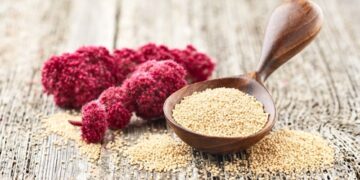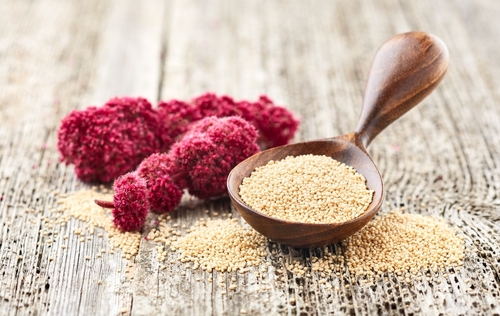There’s something grounding about returning to the basics—especially when the basics come from ancient soil.
When I was rebuilding my relationship with food, I stopped chasing trendy powders and started looking for simple, whole sources of nourishment. I needed energy that didn’t spike and crash. I needed protein that didn’t leave me bloated or sluggish. And most of all, I needed food that respected my body’s rhythms.
That’s when I began working with ancient grains like quinoa and amaranth. Not just because they were gluten-free or plant-based—but because they felt good. Nourishing. Complete.
These grains have been staples in traditional diets for thousands of years. They offer all nine essential amino acids, slow-burning carbohydrates, and minerals that modern diets often lack. They’re gentle on the gut, versatile in the kitchen, and deeply supportive for anyone looking to fuel their body with integrity.
What Makes a Superfood “Protein-Rich”?
When people think protein, they often default to animal sources or protein powders. But true nourishment isn’t just about grams—it’s about the full profile. Ancient grains like quinoa and amaranth don’t just deliver protein. They bring fiber, iron, magnesium, and complex carbohydrates—all essential for energy, hormone health, and muscle repair.
The key difference is balance. These grains digest more slowly, sustain you longer, and come with the added benefit of being anti-inflammatory for most bodies. For anyone avoiding gluten or working with food sensitivities, they’re some of the most reliable and deeply nourishing staples available.
Quinoa: The Queen of Plant-Based Protein
Quinoa has been cultivated in the Andes for over 5,000 years and was considered sacred by the Inca, who called it the “mother grain.” Technically a seed (though often called a grain), quinoa is a complete protein, offering all essential amino acids in a digestible, anti-inflammatory form.
Nutritional Highlights (per 1 cup cooked):
-
~8g protein
-
~5g fiber
-
High in magnesium, iron, zinc, and folate
-
Naturally gluten-free
Beyond its protein content, quinoa’s rich mineral profile makes it a valuable support for metabolism, immune function, and hormonal balance—especially for menstruating or active individuals.
Quinoa is light yet hearty, making it ideal in bowls, salads, soups, or even breakfast porridges. I often batch cook a few cups at the start of the week, ready to toss into whatever my body asks for.
Amaranth: The Underestimated Warrior Grain
Amaranth is one of those ancient grains that doesn’t get enough attention. Cultivated by the Aztecs, it was prized for its ability to sustain energy over long periods and nourish both body and spirit.
It’s a little earthier in flavor than quinoa, with a porridge-like texture when cooked. But it shines when used with intention.
Nutritional Highlights (per 1 cup cooked):
-
~9g protein
-
~5g fiber
-
High in calcium, iron, magnesium, and phosphorus
-
Contains lysine—an amino acid missing from most grains
Amaranth is particularly helpful for those who need steady energy without spikes. It supports bone health, cardiovascular function, and muscle recovery—making it an excellent base grain for active or recovering bodies.
I love cooking amaranth with coconut milk and warming spices for a breakfast bowl, or folding it into veggie patties with lentils and herbs. It’s versatile, grounding, and incredibly nourishing.
Other Gluten-Free, Protein-Rich Plant Alternatives
While quinoa and amaranth are stars in their own right, they’re part of a larger family of plant-based protein heroes worth rotating into your meals:
-
Buckwheat: Despite its name, buckwheat is gluten-free and packed with rutin, a flavonoid that supports vascular health. It cooks like rice and pairs well with roasted vegetables or in soba noodles (look for 100% buckwheat versions).
-
Teff: The tiny seed behind Ethiopian injera bread, teff is rich in iron, resistant starch, and about 10g of protein per cup. Its nutty flavor is lovely in porridge or pancakes.
-
Millet: Mild, fluffy, and often used in Ayurvedic diets, millet is soothing for digestion and supports thyroid and nervous system function.
-
Lentils & Chickpeas: While technically legumes, not grains, these pair beautifully with ancient grains to form complete, high-protein meals—especially when combined with seeds or greens.
These foods don’t just feed the body—they help it recover, stabilize, and build true strength from the inside.
Tips for Cooking and Integration
-
Soak or rinse before cooking: Quinoa contains saponins, natural compounds that can make it bitter or harder to digest. A quick rinse helps. Some grains benefit from an overnight soak to improve digestibility.
-
Batch cook for the week: Cook 2–3 grains at once and rotate them through your meals to avoid boredom and simplify your routine.
-
Spice intentionally: Ancient grains absorb flavor beautifully. Use warming spices, mineral-rich broths, or bright herbs to elevate their natural taste.
-
Pair with healthy fats: Olive oil, avocado, tahini, or nuts help your body absorb fat-soluble vitamins and increase satiety.
-
Don’t forget the greens: A simple bowl of quinoa, roasted veg, and a handful of arugula or sautéed kale can become a powerhouse meal with very little effort.
Final Thoughts
Ancient grains have a quiet strength. They don’t promise transformation overnight—but they offer the kind of steady, reliable nourishment that allows real change to take root.
When I shifted my focus from what I was cutting out to what I was adding in—these grains became allies. They’re simple. Grounded. Healing. And they offer a powerful reminder that the food we’ve always needed might not come from a package, but from the earth, whole and unchanged.
For anyone walking the path of balance—especially those navigating fatigue, hormone shifts, or gluten sensitivity—quinoa, amaranth, and their plant-based cousins are not just allowed. They’re essential.



























